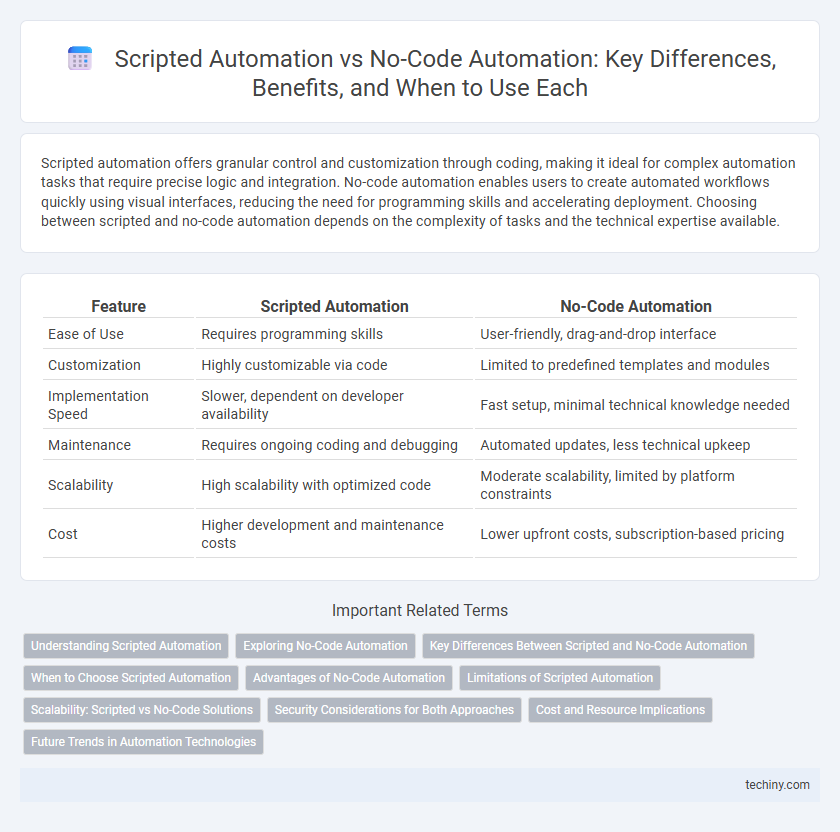Scripted automation offers granular control and customization through coding, making it ideal for complex automation tasks that require precise logic and integration. No-code automation enables users to create automated workflows quickly using visual interfaces, reducing the need for programming skills and accelerating deployment. Choosing between scripted and no-code automation depends on the complexity of tasks and the technical expertise available.
Table of Comparison
| Feature | Scripted Automation | No-Code Automation |
|---|---|---|
| Ease of Use | Requires programming skills | User-friendly, drag-and-drop interface |
| Customization | Highly customizable via code | Limited to predefined templates and modules |
| Implementation Speed | Slower, dependent on developer availability | Fast setup, minimal technical knowledge needed |
| Maintenance | Requires ongoing coding and debugging | Automated updates, less technical upkeep |
| Scalability | High scalability with optimized code | Moderate scalability, limited by platform constraints |
| Cost | Higher development and maintenance costs | Lower upfront costs, subscription-based pricing |
Understanding Scripted Automation
Scripted automation involves writing code to create customized workflows, enabling precise control over complex processes and integration with diverse systems. It requires programming knowledge and offers flexibility to tailor automation scripts to specific business needs, making it suitable for advanced use cases and environments with unique requirements. Mastery of scripting languages like Python, JavaScript, or PowerShell is essential to effectively develop, debug, and maintain these automated solutions.
Exploring No-Code Automation
No-code automation platforms empower users to create workflows without writing code, enabling faster deployment and reducing development costs compared to scripted automation. These tools utilize visual interfaces and drag-and-drop functionality to streamline integration across applications and services, increasing accessibility for non-technical users. By minimizing dependency on IT resources, no-code automation accelerates business processes and enhances organizational agility.
Key Differences Between Scripted and No-Code Automation
Scripted automation relies on custom code written in programming languages like Python or JavaScript, offering high flexibility and control for complex tasks and integrations. No-code automation platforms use visual interfaces and pre-built connectors, enabling users without coding skills to automate workflows quickly and efficiently. Key differences include the need for technical expertise, the level of customization, and the speed of deployment, with scripted automation suited for highly specialized solutions and no-code focused on rapid, user-friendly implementation.
When to Choose Scripted Automation
Scripted automation is ideal for complex workflows requiring precise customization and integration with multiple systems, especially in software development, IT operations, and data processing tasks. It offers granular control and flexibility through programming languages like Python or JavaScript, enabling tailored solutions that no-code platforms cannot accommodate. Choose scripted automation when scalability, performance, and unique business logic are essential for meeting specific automation goals.
Advantages of No-Code Automation
No-code automation platforms empower users to create workflows without programming knowledge, drastically reducing development time and costs. These tools enhance accessibility by enabling business teams to automate repetitive tasks independently, increasing productivity and operational efficiency. Furthermore, no-code solutions offer flexibility through visual interfaces and prebuilt integrations, accelerating deployment and minimizing errors compared to scripted automation.
Limitations of Scripted Automation
Scripted automation often requires extensive programming knowledge, limiting accessibility for non-developers and increasing reliance on specialized IT staff. It struggles with adaptability, as changes in workflows demand time-consuming code modifications and debugging. Maintenance becomes complex and costly due to script fragility and compatibility issues with evolving software environments.
Scalability: Scripted vs No-Code Solutions
Scripted automation offers high scalability by enabling custom code tailored to complex workflows and large-scale integrations, ensuring precise control and performance optimization. No-code automation provides rapid deployment and ease of use but may face limitations in handling extensive, highly customized processes as scale increases. Organizations aiming for scalable automation solutions should evaluate their long-term complexity and integration needs to choose between the adaptability of scripted approaches and the accessibility of no-code platforms.
Security Considerations for Both Approaches
Scripted automation offers granular control over security configurations, allowing developers to implement custom encryption, authentication, and access controls tailored to specific organizational requirements. No-code automation platforms provide built-in security features and compliance standards, but they may expose vulnerabilities due to limited customization and potential dependency on third-party services. Evaluating both approaches requires assessing the trade-offs between flexibility in security management with scripted solutions and the convenience and standardized protections of no-code tools.
Cost and Resource Implications
Scripted automation requires skilled developers, increasing initial costs and ongoing maintenance expenses but allows for highly customized workflows tailored to complex business needs. No-code automation significantly reduces upfront costs by enabling non-technical users to create and modify processes, minimizing dependence on specialized IT resources. While no-code platforms lower resource implications, they may incur subscription fees and limitations in scalability compared to scripted solutions.
Future Trends in Automation Technologies
Scripted automation remains essential for complex, customized workflows requiring precise control and integration with legacy systems, while no-code automation democratizes access, enabling non-technical users to build and deploy automated processes rapidly. Future trends indicate a growing convergence where AI-powered platforms offer hybrid solutions combining the flexibility of scripting with the simplicity of no-code interfaces. Enterprises are increasingly adopting intelligent automation frameworks that leverage machine learning, natural language processing, and robotic process automation (RPA) to enhance scalability, adaptability, and efficiency across diverse business functions.
Scripted Automation vs No-Code Automation Infographic

 techiny.com
techiny.com